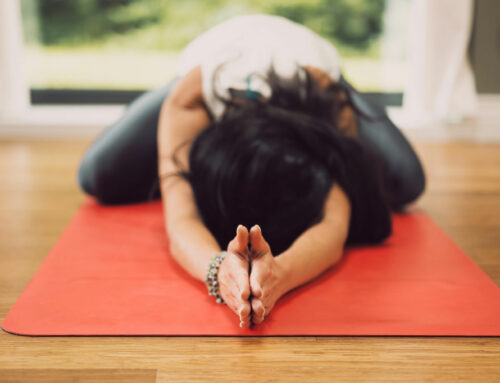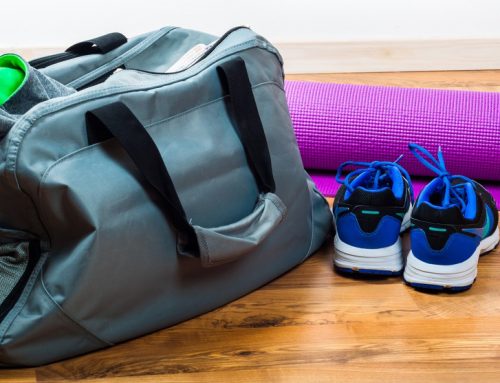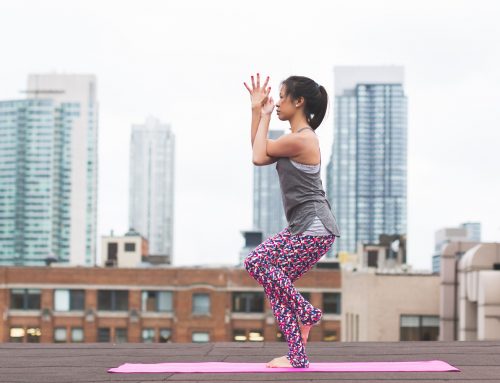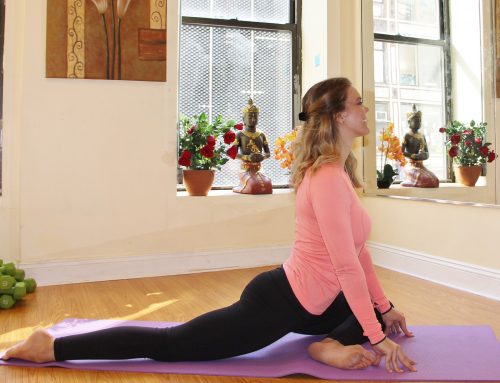By Shai Plonski
As I move her from the cobra into the half plough and then into yoga mudra, I feel her heartbeat, her energy, her every vibration. It is almost as though we are one source focused towards the same goal, releasing deep inner tension as we work to the rhythm of our own loving kindness…
Thai Yoga Massage was first introduced to me as a healing form that is like assisted yoga. It was one of the first attractions that turned me on to this ancient technique. But now, through my own experiences as a massage teacher and yoga instructor, what shines through is how the connection between these two healing arts resonates in multiple ways.
As Kam Thye Chow, who has been teaching these arts for the past 17 years says, “The greatest yoga secret is not in India, but in Thailand. It is a living art that is an established part of the traditional medical system. Millions of Thai receive Thai massage to treat physical, mental illnesses and a Thai Masseur uses yoga postures, massage techniques and a spiritual power as part of the treatment.”
![]()
What is Thai Yoga Massage?
Thai Yoga massage is a healing form where yoga and bodywork meet. It is fully clothed massage performed on a mat, combining yoga postures, myriad massage techniques, as well as breathing meditation.
In Thailand it has long existed as a way for Buddhists to share the fruits of their meditation, helping people realize their own potential in a nurturing and healing way. As both giver and receiver feel their bodies being mindfully manipulated, the resulting experience then, is like a sacred dance where both practitioner and recipient are left feeling invigorated, opened up and connected with the universal source of life that permeates our beings.
In effect, Thai Yoga massage satisfies the fundamental essence of what you would expect from the best that yoga has to offer. However, according to Kam Thye, who was taught by several leading Thai massage teachers during his six years in Thailand, “Most masters there don’t have a clue about yoga. All they’ve heard is that it’s an art from India.”
What is Thai Yoga Massage?
Re-establishing the Link
It is only with Thai Yoga Massage’s steady gain in popularity in North America, where the great majority of Thai Yoga Massage therapists are either yoga teachers or long time practitioners, that a deeper understanding and exploration of the connection has ensued.
“I have a lot of yoga students who, when they receive Thai Yoga Massage, reach a higher level in their own yoga practice,” says Kam Thye, “and a lot of yoga teachers study Thai Yoga Massage with me solely because they can then bring their students into yoga postures without hurting them.”
Therefore, reconnecting yoga and Thai Yoga Massage is an important part of the work, and when you set out on that pursuit, you find that the connections practically leap out at you.
Breaking it down
Dr. Jivaka, venerated in Thailand as the founder of Thai Yoga Massage in approximately 500 BD, is also described in various Buddhist texts as both friend and personal physician of the Buddha. Trained in the practice of Ayurvedic medicine, often referred to as a sister science of yoga, he applied those principles into a form of massage which would eventually come to be known as Thai Yoga Massage…
As Buddhism left India and traveled the Asian continent, Dr. Jivaka’s healing techniques went along for the ride, reaching Thailand around the 2nd or 3rd century BC.
When you start to piece together the puzzle, the image that emerges is like a chain that continues to be strongly linked even after a 2500-year separation from its Indian heritage. To begin, the roots of both yoga and Thai Yoga Massage are firmly planted in the 5 koshas (or bodies). That is, there is an underlying knowledge tat the success of these arts is based on the reality that you are working on more than just the physical body.
There are in fact 5 bodies or koshas that both yoga teachers and massage practitioner are conscious of: The physical body or annamayakosha, the energetic body or pranamayakosha, the emotional body or manamayakosha, the intellectual body or vijamayakosha, and finally the blissful body, or anandamayakosha. To examine the link in depth is to take us through each of these koshas.
Annamaya Kosha – the Physical Body
“The first thing to notice when someone is receiving Thai Yoga Massage is we can clearly see some of the yoga postures being applied, like the cobra, the plough, the half plough, the butterfly, the bridge, the fish, just to name a few examples,” says Kam Thye. “It looks like yoga, and being practiced on feels like yoga.” Moreover, the practitioner will put himself into a number of yoga postures, such as the warrior, diamond, and open diamond when applying the massage to ensure proper alignment and a free flow of energy.
Furthermore, Kam Thye adds, “The benefits are unlimited… When receiving a Thai Yoga Massage the body is being moved, mobilized… Your whole body is opened up, stretched up, inducing the flow of blood and nutrients throughout your body… With the manipulation of the physical body, working on the nervous system, the circulatory system, the skeletal system, you are making the person very happy. They can finally and totally relax.”
“You just have to look at it,” says Emily Moody who is both a Shivananda Yoga teacher as well as Thai Yoga Massage ractitioner. “Actually, I’m looking over there at a Thai painting and that’s a yoga posture. He’s doing Nataraj (the dancer pose). There’s a complete relationship that is obvious through the postures. And, as you go deeper into it, it gets more exciting because you start really seeing the connection.”
Pranamaya Kosha – the Energetic Body
Essential to both practices is the unblocking and conscious manipulation of prana. As Dr. Bali, a yoga instructor for more than 35 years explains it, “There is a subtle source of energy where the body is being conceived from… Our objective is to go into the deper reality where it’s all taking place, where it’s all coming from. That field has to be refined. That’s what yoga does, that’s what breathing does.” And according to Kam Thye, that’s also what Thai Yoga Massage does.
This link is further embedded in the knowledge base of both practices. For example, both Thai Yoga Massage practitioners and yoga instructors map the body through an identical series of energy lines. The former refer to them as nadi lines, the latter as sen lines. Even the language used in naming the lines has carried forth through the years. One example that Kam Thye points out, is the left and right energy lines that run from the top of the head down the side of the body. “In the Thai tradition, they are called sen ita and sen pinkala, and in the Indian tradition they’re called ita nadi and pinkala nadi.”
A distinguishing characteristic of Thai Yoga Massage is that you apply systematic pressure along the myriad energy lines that run throughout the body to help the receiver get in touch with their prana.
Similarly, as Dr. Bali explains, “In yoga you do that manipulation yourself and in Thai Yoga Massage you work with someone who specializes in this… Most of the work is working from the pressure points to unload the system of the overload it would be going through otherwise, and to calm the mind. To create that positive feedback of comfort, rather than the discomfort that we feel under stress.”
Manomaya Kosha – the Emotional Body
Stress. The magic word that both yoga and Thai Massage must contend with most to help the body heal itself profoundly and naturally. In essence, the work we do to unblock prana is what allows us to access hidden emotions, deep tension and chronic pain.
As Dr. Bali says, “The body is a printout of our own mind. Too often we don’t realize the damage that stress causes until it’s too late. So then we get these symptoms, whether it’s asthma, migraines, hypertension, chronic pain, arthritis… The purpose of yoga is to keep working with your own body, to not allow the accumulation of toxins or the overload of stress. Our system is like any other system: When there’s an overload there will be a short circuit. So how to reconnect the system if these short circuits have taken place? That’s what yoga postures do. In a very conscious way you bring your attention in your own body and you begin to experience it.”
Every organ, every tissue of the body is able to give us a message telling us how it feels. One vital aspect of both yoga and Thai Yoga Massage is that it teaches you tow to be in the moment and to recognize those messages so that you can become the conductor of your own body. Thus, if you are not feeling good, if there are any weak links, then you can consciously reinforce them – and once these weak links are being rebuilt, overall feelings of wellness come automatically.
As Arlene McGibbon, a yoga teacher for over 20 years and a recent recipient of the massage describes it, “Thai Yoga Massage is a like a spring cleaning. Over my many years of practice, I have learned that the individual can’t always do it alone. Sometimes, to deepen the experience, to unlock hidden pain, you need help.”
Vijnamaya Kosha – the Intellectual Body
To allow ourselves to go deeper, to access our hidden resourcefulness and take our bodies to a new level of health, the real work begins as we try to tame the mind.
Kapalabati, alternate nostril breathing, Ashtanga breath, and Kundalini breath are all examples of how different schools and teachers of yoga mobilize the breath into action. Similarly, Thai Yoga Massage uses a number of breathing techniques, such as deep breathing directed breathing and induced breathing to align the rhythmic flow of the experience.
Through both yoga and Thai Yoga Massage are born out of the ancient meditative techniques, they certainly differ in their approaches. Yoga uses chanting, and a wide variety of breath work; Thai Yoga Massage grows out of Vipassana meditation, or moment-to-moment awareness, where the goal is to be mindful of each breath and sensation in body without any direct attempt to manipulate it. However, they are both aimed toward the same end. As Dr. Bali puts it, “We are trying to bring that level of salience and timelessness into consciousness.”
Allowing us, in one sense, to go deeper into ourselves, so that we have a greater success I accomplishing our goals, be it to release stress, unblock the flow of energy, go further into our postures or to create calming vibrations of peace. While in another sense, it allows us to come into contact with our blissful body, where all we know are inexhaustible sensations of happiness.
Anandamaya Kosha – the Blissful Body
It is our increased ability to revel in this most subtle of bodies, which is part of the inherent makeup of each and every one of us, that allows us to take ourselves to the next level of wellness. “We are all wired for ecstasy,” explains Dr. Bali, “therefore, every cell of the body is directing us towards repair, renewal and replenishment.
All yoga disciplines and Thai Yoga Massage sessions are aimed towards reaching this level of awareness, so that by experiencing this innate wisdom, we hen have the ability to make that more a part of who we are and how we live. Or, as Dr. Bali describes it, “Happiness is not something we acquire. Happiness is what we are. The methodology of yoga and Thai Yoga Massage is to help it unfold. It is to access that level of awareness which is our most subtle of bodies.”
And then, whether it’s through yoga or Thai Yoga Massage, when you reach that kind of reverent space, deeply in touch and aware of yourself from the inside out, it becomes abundantly clear. The true source of their connection is in how they use similar physical, practical means, to tap into the same inexhaustible resource: love.
For us North Americans, understanding this connection is an essential part of the practice because, as Kam Thye Chow reminds us, “To expose the art of Thai Yoga Massage and connect it with yoga, you make it as mainstream as possible, and that can only do well for humankind”.






